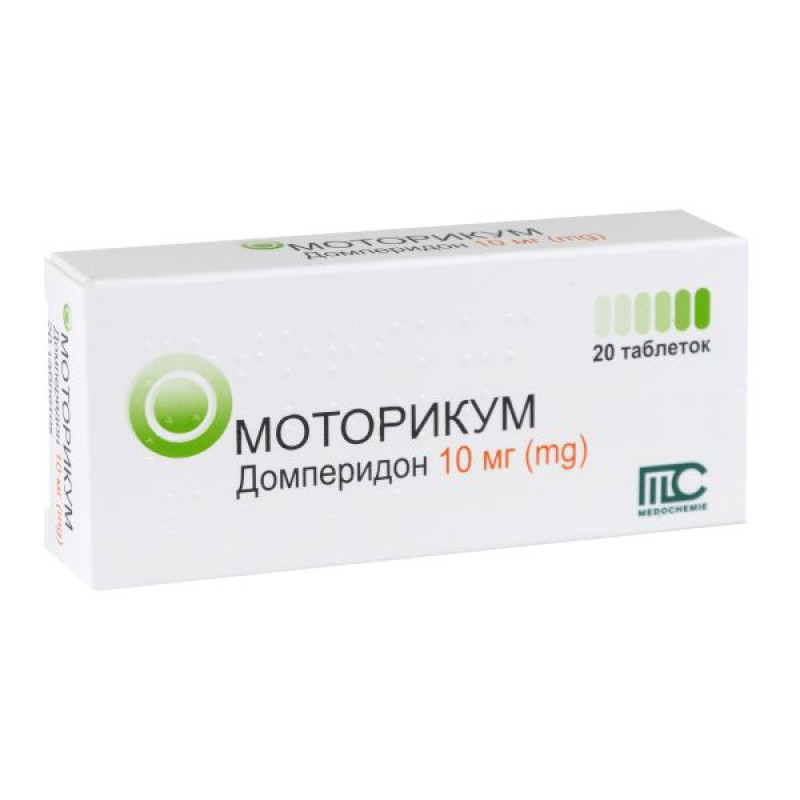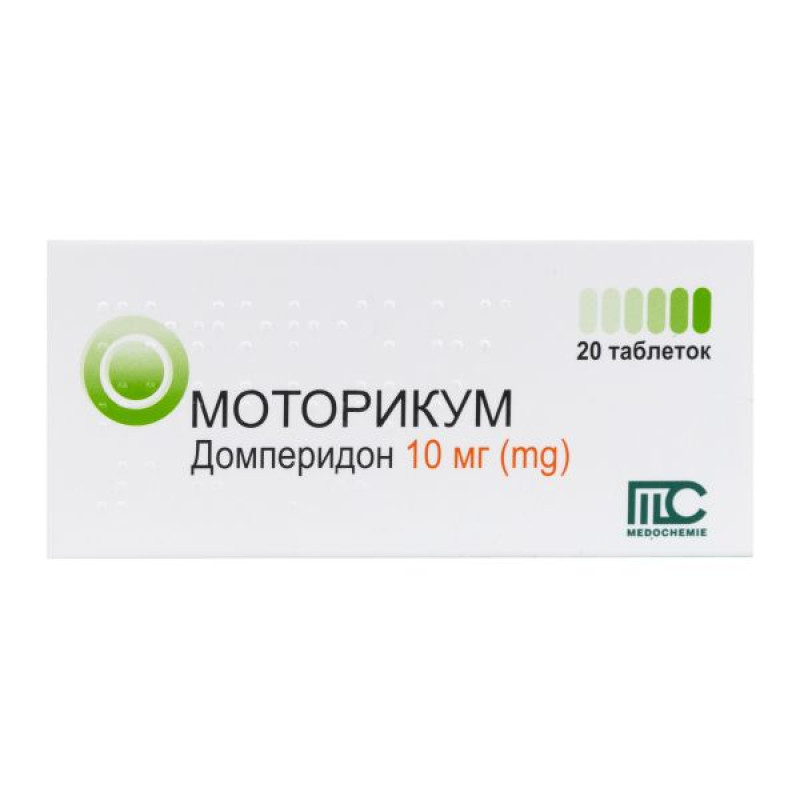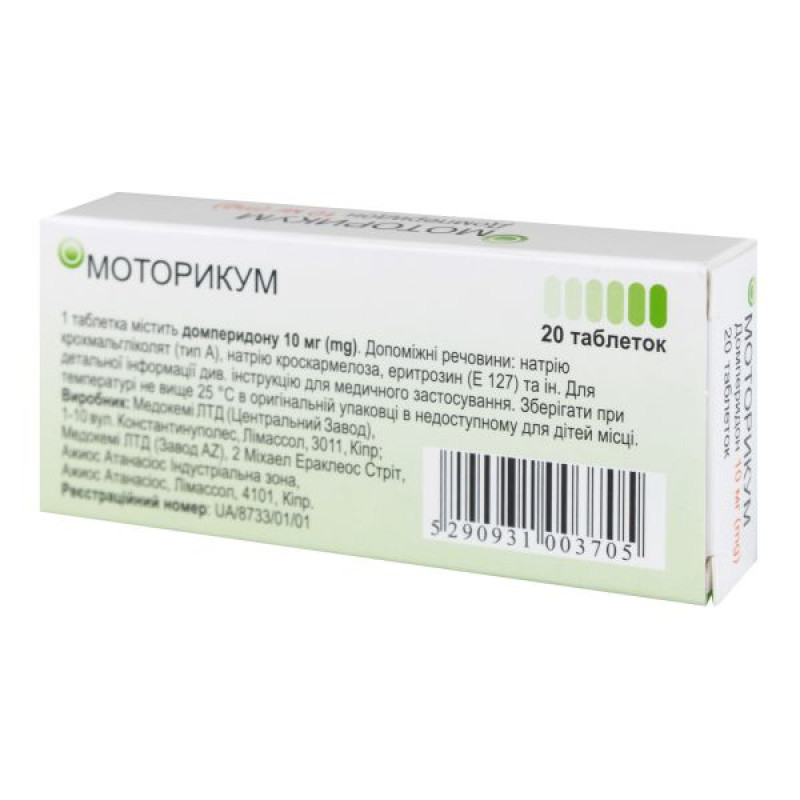Motorikum tablets 10 mg blister No. 20

Pharmacological properties
Pharmacodynamics. Domperidone is a dopamine antagonist with antiemetic properties. Domperidone penetrates the blood-brain barrier to a small extent. The use of domperidone is very rarely accompanied by extrapyramidal side effects, especially in adults, but domperidone stimulates the release of prolactin from the pituitary gland. Its antiemetic effect is probably due to a combination of peripheral (gastrokinetic) action and antagonism to dopamine receptors in the chemoreceptor trigger zone, which is located outside the BBB in the posterior part (area postrema). Animal studies, as well as low concentrations determined in the brain, indicate a predominant peripheral effect of domperidone on dopamine receptors.
Studies in humans have shown that when administered orally, domperidone increases lower esophageal pressure, improves antroduodenal motility, and accelerates gastric emptying. Domperidone does not affect gastric secretion.
Pharmacokinetics. Absorption. Domperidone is rapidly absorbed when taken orally on an empty stomach, C max in blood plasma is reached after 30-60 min. The low absolute bioavailability of oral domperidone (about 15%) is due to extensive first-pass metabolism in the intestinal wall and in the liver. Although in healthy people the biological value of domperidone increases when taken after a meal, patients with gastrointestinal complaints should take domperidone 15-30 min before a meal. Reduced gastric acidity reduces the absorption of domperidone. When the drug is taken orally after a meal, maximum absorption is somewhat delayed.
Distribution. When administered orally, domperidone does not accumulate and does not induce its own metabolism; C max in plasma after 90 min (21 ng / ml) after 2 weeks of oral administration of 30 mg / day was almost the same as after taking the first dose (18 ng / ml). Domperidone is 91-93% bound to plasma proteins. Studies of the distribution of domperidone, conducted in animals using a radioactive isotope-labeled drug, showed its significant distribution in tissues, but low concentrations in the brain. In animals, a small amount of the drug penetrates the placenta.
Metabolism: Domperidone is rapidly and extensively metabolized in the liver by hydroxylation and N-dealkylation.
Excretion in urine and feces is 31 and 66% of the oral dose, respectively. Excretion of the drug in unchanged form is a small percentage (10% in feces and about 1% in urine). T ½ from blood plasma after a single dose is 7-9 hours in healthy volunteers, but is prolonged in patients with severe renal failure.
Indication
To relieve symptoms of nausea and vomiting
Application
It is recommended to take Motoricum before meals. If taken after meals, the absorption of the drug is somewhat slowed down. The duration of treatment should not exceed 2 weeks.
To relieve symptoms of stomach discomfort after meals. Adults and children over 12 years of age and weighing at least 35 kg: 1 tablet (10 mg) 3-4 times a day. Maximum daily dose - 4 tablets (40 mg). Maximum duration of treatment - 2 weeks.
For the relief of symptoms of nausea and vomiting lasting less than 48 hours. Adults and children over 12 years of age and weighing at least 35 kg: 1 tablet (10 mg) 3-4 times a day. Maximum duration of treatment - 48 hours.
Contraindication
Patients with established hypersensitivity to the drug or excipients;
patients with a prolactin-secreting pituitary tumor (prolactinemia);patients with severe or moderate liver and/or kidney dysfunction (see Special warnings and precautions for use);
patients with known prolongation of cardiac conduction intervals, particularly Q-Tc, patients with significant electrolyte imbalances or underlying heart disease, such as congestive heart failure (see Precautions);
patients with hepatic insufficiency; if stimulation of gastric motility may be dangerous, for example, in gastrointestinal bleeding, mechanical obstruction or perforation; concomitant use of ketoconazole, erythromycin or other potent CYP 3A4 inhibitors is contraindicated;Concomitant use of drugs that prolong the QT interval, such as fluconazole, erythromycin, itraconazole, oral ketoconazole, posaconazole, ritonavir, saquinavir, telaprevir, voriconazole, clarithromycin, amiodarone, telithromycin is contraindicated (see Precautions and Interactions).
Side effects
Provided that the recommendations for dosage and duration of treatment are followed, domperidone is usually well tolerated and adverse events occur infrequently.
Immune system disorders: allergic reactions, including anaphylaxis, anaphylactic shock, hypersensitivity.
On the part of the endocrine system: increased prolactin levels.
Mental disorders: nervousness, irritability, agitation, depression, anxiety, decreased or absent libido.
Nervous system: insomnia, dizziness, thirst, convulsions, lethargy, headache, drowsiness, akathisia, extrapyramidal disorders.
Cardiovascular system: edema, palpitations, disturbances in the rate and rhythm of heart contractions, prolongation of the QT interval (frequency unknown), serious ventricular arrhythmias, sudden cardiac death.
Skin and subcutaneous tissue disorders: itching, rash, urticaria, angioedema.
Reproductive system and breast disorders: galactorrhea, breast enlargement/gynecomastia, breast tenderness, breast discharge, amenorrhea, breast swelling, breast pain, lactation disorder, irregular menstrual cycle.
Musculoskeletal and connective tissue disorders: leg pain.
From the urinary system: urinary retention, dysuria, frequent urination.
General disorders: asthenia.
Other: conjunctivitis, stomatitis.
Changes in laboratory parameters: increased levels of ALT, AST and cholesterol, abnormal liver function tests, increased levels of prolactin in the blood.
Because the pituitary gland is located outside the blood-brain barrier, domperidone may cause an increase in prolactin levels. In rare cases, this hyperprolactinemia may lead to neuroendocrine side effects such as galactorrhea, gynecomastia, and amenorrhea.
During post-marketing use of the drug, no differences in the safety profile of the drug in adults and children were noted, with the exception of extrapyramidal disorders and other phenomena, seizures and CNS-related disorders, which were detected mainly in children.
Special instructions
Motorikum is not recommended for use during injection.
Motoricum should be used with caution in elderly patients or in patients with existing heart disease or a history of heart disease.
Cardiovascular Effects: Domperidone has been associated with prolongation of the QT interval on the ECG. Isolated cases of QT prolongation and ventricular fibrillation have been reported in patients taking domperidone. These reports included patients with other predisposing risk factors, electrolyte abnormalities, and concomitant medications that may have been contributing factors.
QT prolongation in accordance with the recommended regimen at usual therapeutic doses (10 or 20 mg 4 times a day) is of no clinical significance.
Warning: Domperidone should be used with caution in patients with mild hepatic and/or renal impairment.
Due to the increased risk of ventricular arrhythmia, Motoricum is contraindicated in patients with prolongation of cardiac conduction intervals, in particular Q-Tc, with significant electrolyte imbalance (hypokalemia, hyperkalemia, hypomagnesemia) or bradycardia, or with underlying heart disease such as congestive heart failure. Electrolyte imbalance (hypokalemia, hyperkalemia, hypomagnesemia) and bradycardia are known to be conditions that increase proarrhythmic risk.
If signs or symptoms that may be associated with cardiac arrhythmia appear, Motoricum should be discontinued and the patient should immediately consult a doctor.
Renal impairment. T ½ of domperidone in severe renal impairment is prolonged. With prolonged use, the frequency of dosing of domperidone should be reduced to 1 or 2 times a day, depending on the severity of the impairment. A dose reduction may also be required.
Antacids or antisecretory drugs should not be taken simultaneously with oral forms of Motoricum, as they reduce the bioavailability of domperidone (see Interactions with other drugs). When used simultaneously, Motoricum should be taken before meals, and antacids or antisecretory drugs after meals.
Use with Ketoconazole: Interaction studies with oral ketoconazole have shown QT prolongation. Therefore, alternative treatment should be considered if antifungal therapy with ketoconazole is indicated (see Interactions with other medicinal products).
Motoricum tablets contain lactose, so the drug should not be used in patients with lactose intolerance, galactosemia and glucose/galactose malabsorption.
The following information should be considered regarding the risk of cardiovascular complications caused by medicines containing domperidone:
Domperidone may be associated with an increased risk of serious ventricular arrhythmias or sudden cardiac death; the risk of serious ventricular arrhythmias or sudden cardiac death may be higher in patients over 60 years of age or at oral doses of the drug above 30 mg/day. Therefore, Motoricum should be used with caution in elderly patients. Patients over 60 years of age should consult a doctor before taking Motoricum; domperidone should be prescribed to adults and children in the most effective dose.The risk-benefit ratio of domperidone remains favorable.
The amount of domperidone that can enter the infant through breast milk is extremely low. The maximum relative dose for infants (%) is estimated to be about 0.1% of the maternal dose adjusted for body weight. It is not known whether it harms the infant, so mothers taking Motoricum should refrain from breastfeeding. Caution should be exercised in the presence of risk factors for prolongation of the Q-Tc interval in breast-fed infants. After exposure as a result of the drug penetrating into breast milk, the occurrence of side effects, including cardiological effects, cannot be excluded.
Ability to influence the reaction speed when driving vehicles or other mechanisms. Given the side effects from the nervous system, patients need to be careful when driving vehicles or other mechanisms.
Children. The drug is used to treat children aged 12 years and over and weighing at least 35 kg. Domperidone should be prescribed to children in the minimum effective dose for the shortest period.
Interactions
Anticholinergic drugs can neutralize the antidyspeptic effect of Motoricum. Due to pharmacodynamic and/or pharmacokinetic interaction, the risk of QT interval prolongation increases.
Antacids and antisecretory drugs should not be taken simultaneously with Motoricum, as they reduce its bioavailability after oral administration (see Special Precautions for Use).
Domperidone is metabolized primarily by CYP 3A4. Concomitant use of drugs that significantly inhibit this enzyme may lead to increased plasma levels of domperidone.
Clinically significant changes in the QT interval have been observed when domperidone was used concomitantly with potent CYP 3A4 inhibitors that can prolong the QT interval. Therefore, the concomitant use of domperidone with certain drugs is contraindicated (see Adverse Reactions).
The concomitant use of the following drugs with domperidone is contraindicated.
All drugs that prolong the QT interval:
Class IA antiarrhythmics (e.g. disopyramide, quinidine, hydroquinidine); Class III antiarrhythmics (amiodarone, dofetilide, dronedarone, ibutilide, sotalol); Some neuroleptics (e.g. haloperidol, pimozide, sertindole); Some antidepressants (e.g. citalopram, escitalopram); Some antibiotics (e.g. levofloxacin, moxifloxacin, erythromycin, spiramycin); Some antifungals (e.g. pentamidine); Some antimalarials (e.g. halofantrine, lumefantrine); Some gastrointestinal drugs (e.g. cisapride, dolasetron, prucalopride); Some antihistamines (e.g. mecitazine, mizolastine); Some drugs used in cancer (e.g. toremifene, vandetanib, vincamine); Some other drugs (e.g. bepridil, methadone, diphemanil).Examples of strong CYP 3A4 inhibitors with which Motoricum is contraindicated include:
azole antifungals such as fluconazole*, itraconazole, ketoconazole* and voriconazole*; macrolide antibiotics such as clarithromycin* and erythromycin*; protease inhibitors*; HIV protease inhibitors such as amprenavir, atazanavir, fosamprenavir, indinavir, nelfinavir, ritonavir and saquinavir; calcium antagonists such as diltiazem and verapamil; amiodarone*; amrepitant; nefazodone; telithromycin*.* Prolong the Q-Tc interval.
The simultaneous use of the following substances requires caution.
Use with caution with drugs that cause bradycardia and hypokalemia, as well as with the following macrolides that can cause QT prolongation: azithromycin and roxithromycin (clarithromycin is contraindicated as it is a potent CYP 3A4 inhibitor).
Domperidone should be used with caution in combination with potent CYP 3A4 inhibitors that have not been shown to prolong the QT interval, such as indinavir, and patients should be closely monitored for signs or symptoms of adverse effects.
The above list is representative, but far from exhaustive.
Motorikum can be combined with:
neuroleptics, the effect of which it enhances; dopaminergic agonists (bromocriptine, L-dopa), the undesirable peripheral effects of which, such as digestive disorders, nausea, vomiting, it suppresses without neutralizing the basic properties.Theoretically, since Motoricum has a prokinetic effect on the stomach, it may affect the absorption of concomitantly administered oral medications, particularly extended-release or enteric-coated formulations. However, in patients whose condition had already been stabilized on digoxin or paracetamol, concomitant use of domperidone did not affect the blood levels of these medications.
Overdose
Symptoms: Symptoms of overdose may include agitation, impaired consciousness, convulsions, disorientation, drowsiness and extrapyramidal reactions.
Treatment. There is no specific antidote for domperidone, but in case of significant overdose, gastric lavage within 1 hour after ingestion and administration of activated charcoal are recommended, as well as careful patient observation and supportive therapy. Anticholinergic drugs, agents for the treatment of Parkinson's disease may be effective in controlling extrapyramidal reactions.
Storage conditions
At a temperature not exceeding 25 °C in the original packaging.
There are no reviews for this product.
There are no reviews for this product, be the first to leave your review.
No questions about this product, be the first and ask your question.








